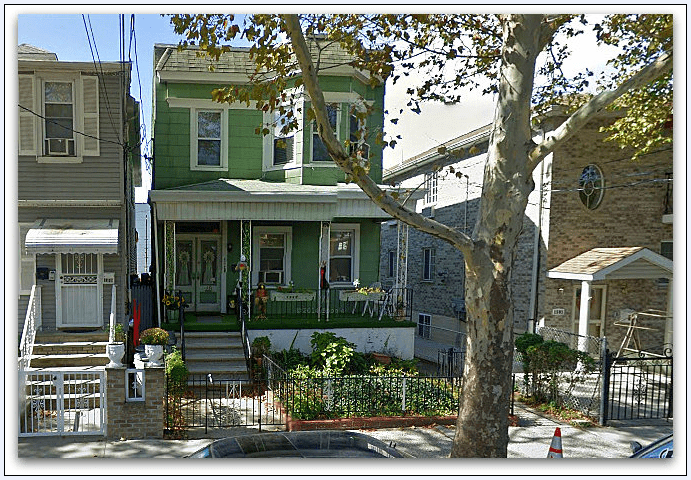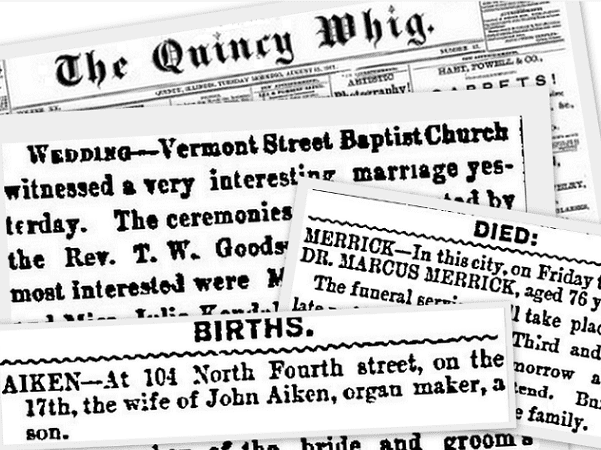I was looking at the 1919 marriage certificate of my cousin George Henry Kemp and his wife Augusta Betty Ehlers.

From earlier research, I already had the basic genealogical information about them – their birth, marriage and death information.
What more could I learn about them from their marriage certificate?
Looking at the information for George, I saw that he was living at 1581 Mayflower Avenue in the Bronx at the time of their marriage. I wondered if that home is still standing? That would be interesting to know. So, I looked at Google Street View, typing in that address – it brought me right to it.

According to Zillow.com that home was built about 1920.
So this was probably their home.
The online List of Enrolled Voters: Borough of the Bronx for 1918 shows that George was enrolled as a Democrat and living at that address. His father John Kemp and step-mother Emily (Mulholland) Kemp are also listed as enrolled voters living at that address – but with no party affiliation designated.
George and August’s marriage certificate says that the wedding was performed in New York by “H. C. Stemp, Clergyman.”
Stemp. You don’t hear that surname very often.
Since he was a minister in New York City, I decided to search for any mention of him in GenealogyBank’s Historical Newspaper Archives.
So I searched for H.C. Stemp – and generated zero search results.
That’s odd.
He was a minister – but there were no references to him in the old newspapers?
So – I Googled him.
Looking for: Rv. H.C. Stemp church New York City, I found only one or two references for him there – but one of the Google search results linked him to St. John’s Lutheran Church in New York City.
OK – let’s see if that works.
Hmm.
A few more searches in GenealogyBank’s old newspapers – but still nothing.
There must be something wrong with the spelling of that surname.
So I searched GenealogyBank again using only his initials and the reference to the Lutheran Church in New York.
I limited my search to 1919, the year he performed the wedding of my cousin. Since I was searching on the initials “H. C.” I also limited the search results to just New York and the immediate bordering states Vermont, Massachusetts and Connecticut.
That generated a reasonable four search results – including this one.
Bingo – that’s him – and look at that, his surname is spelled Steup not Stemp. Searching again with the correct spelling, I found this newspaper article about him. It turns out that the Steups were a tribe of pastors.
That article included this photo of the Steup ministers.
I then searched the Internet for more information about St. John’s Lutheran Church.
I quickly found these photographs of the church.
http://www.nycago.org/Organs/NYC/html/StJohnEvLuth.html
http://www.nycago.org/Organs/NYC/html/StJohnEvLuth.html
According to this website:
The Federal-style building with a domed cupola, built in 1821-22 for the Eighth Presbyterian Church, is one of the oldest religious buildings in Greenwich Village. In 1842, the property was sold to St. Matthew’s Episcopal Church, who worshiped here until 1858 when it was purchased for $13,000 by the German Lutherans. Victorian features were added in 1886 by Berg & Clark, and the pediment was inscribed, “Deutsche Evangelish-Lutherische St. Johannes Kirche.”
These contemporary photos of the church, showing the altar area, are likely very similar to the way the church would have looked in 1919 when their wedding was performed.
A German Lutheran Church. That makes sense – Augusta’s family had lived in the Bronx but moved to Stamford, Connecticut, in 1890 when her father bought a butcher shop on the corner of East Main Street and Maple Avenue there.
Looking at Google Street View, I found the building.
Their home and butcher shop was right next door to George’s uncle, William Kemp!
I also found this article, showing that George’s father John Kemp, “a New York [City] policeman” was “having a fine dwelling house erected on the corner of Main street and Myrtle avenue.” That is just to the right of the red “Service and Parts” awning pictured above.
This week when I started this research, I already had George and Augusta’s wedding certificate and their basic genealogical facts.
Armed with the insights from GenealogyBank’s newspapers and the Internet, I really got the rest of their story.
He lived at home with his parents in the Bronx and she lived with her family above their butcher shop in Stamford, Connecticut. By identifying the correct spelling of the minister’s name, I was able to find the church where they were married – and that is likely the church her family attended when they lived in New York City before they moved to Stamford.
With these essential online tools and a little elbow grease you can build your family history from home. It’s amazing what you can find in newspapers.
It’s a Great Day for Genealogy!
Are you attending the RootsTech Genealogy Conference?
GenealogyBank is helping to sponsor the upcoming RootsTech conference in Salt Lake City, Utah, 3-6 February, 2016. If you’re attending, come visit us at booth #523 to discuss genealogy in general, or any specific questions you have about your own family history research.
For more information about RootsTech, visit the website at: http://www.rootstech.org/?lang=eng
Related Articles:
